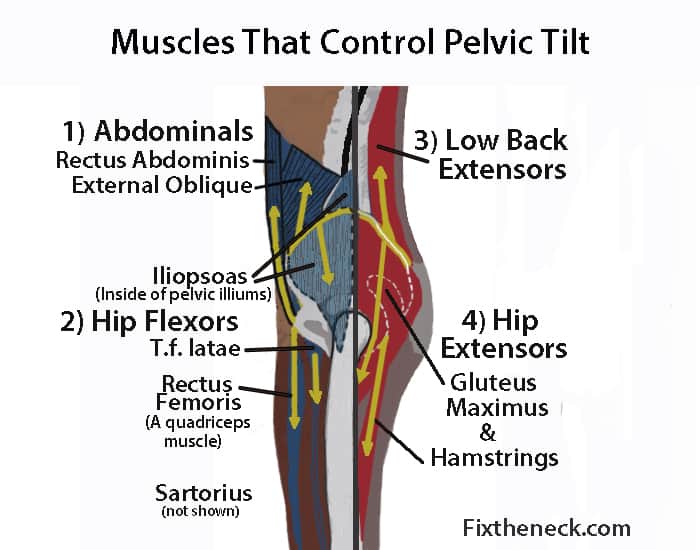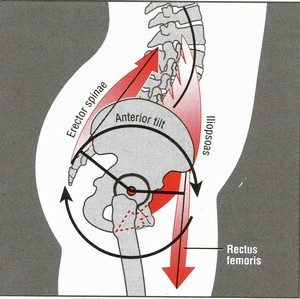
Posterior Pelvic Tilting – Even Simpler
The pelvis speaks volumes. The position in which you hold it dictates whether or not you can use your abs, release your hip flexors, and/or likely have symptoms of back pain. It’s the first thing I check with new clients and one of the first understandings I get across in PE. The pelvis directly influences anything attached to it, which is a heckuva lot:
Since the vast majority of our ‘awake’ time is spent sitting, we cultivate very strong, tight hip flexors. This pulls the pelvis into anterior pelvic tilt:
The kinetic effects of anterior pelvic tilt (or APT) are massive:
Living in anterior pelvic tilt is remedied through routine emphasis on posterior pelvic tilting.
Though a common antidote to APT is prescribed as ‘stretch your hip flexors’ or ‘squeeze your glutes’, little instruction is given as to how. The position of the pelvis has to change in order to make these things effective. Pelvic tilting is a rounding, not a flattening. The distinction is important, because it provides the user with a conceptual framework in which to perform the movement. “Pull your tailbone toward your nose,” describes the process. “Squeeze your glutes,” only offers a command, which could be interpreted in a multitude of ways. Without the action of turning being explained in relation to the end goal, the learner lacks the means to perform what’s being asked.
For a solution to be effective, the user must be willing (and able) to carry it out. The wall hip lift option worked quite well, but I noticed that many of the boys in PE were extremely self conscious of their shorts riding up. I also realized that larger people had trouble holding themselves up in that manner. Any barriers to practice when learning a new skill will lead to less practice.
Compliance occurs when: 1. Access and entry into a movement or position is made easy, and 2. The user understands how a movement or position extends into other desired actions or goals.
Making the set-up and execution of a movement or position easier
The elbow set up requires no wall space or awkward feet-up positioning, You simply need some ground space and the ability to prop your upper back up on your elbows:
The rounding of the upper back encourages the rounding of the lower back. (Notice the head to knees ‘C’ formation.) Once the pelvis rotates the lumbar spine into the ground, the goal is to keep it there as the upper back, shoulders, head and neck ease into laying. The video shows a contrast of pelvic positioning for reference. When the waistband pushes toward by feet and the low back pops off the ground ( I call this ‘creating a tunnel’), the pelvis is anteriorly tilted. A vertical waistband, or one slightly shifted toward the face, represents a neutral to posteriorly tilted pelvis (or ‘squished’ tunnel).
As assistance from the upper body is taken away, work from the lower abs intensifies to hold position. This is the ‘hollowing’ so often referred to in gymnastics or body weight training. Should the low back round up or a tunnel present, APT has crept in. Tension is felt more in the low back than in the abdominals when the pelvis is anteriorly tilted.
Enhancing the effectiveness and awareness of other desired movements
Still, even with everything presented, the impact of the pelvis cannot be fully realized without context. You often have to prove that the little things matter. If you can get the user to feel the immediate effects of a position, they’re much more likely to understand its importance. Using the hips, abs, and hamstrings to emphasize the significance of pelvic control goes a long way in confirming it deserves all of this attention.
HIP FLEXOR STRETCH
Stretching the hip flexors becomes a much different experience when the pelvis isn’t anteriorly tilted:
Once you can fully grasp the basics, you can intensify:
The swiss ball cradles the leg much more effectively than a bench or box. It both absorbs and offers pressure to place you in a position of comfort and control.
DEADBUGS
The hip flexors and abs compete to carry out most leg movements. Shift the biomechanics advantage to the abs by posteriorly tilting the pelvis:
Once you can fully grasp the basics, you can create with intention:
HAMSTRING STRETCH
Anterior pelvic tilt elongates the hamstrings. If you live in APT, the hamstrings will be kept in a stretched position, and stretching them further is often unpleasant:
Henpeckers provide an opportunity for groups to feel how pelvic positioning can both create a stretch and make that stretch go away:
Reach and feel the stretch, get rid of stretch, feel the stretch again, hinge upright.
TO REVIEW:
- The brain gets better at doing whatever we consistently tell it to do.
- The pelvis attaches to, and effects, many things.
- Pelvic tilting is a rounding, not a flattening.
- Compliance is largely dependent on ease of use/ practice
- The elbow set up for posterior pelvic tilting uses the upper back to assist the lower back
- Posterior tilt or hollowing engages the abs
- Explaining how and why little things matter makes them more meaningful
- Getting people to feel desired tension enhances kinesthetic understanding
- Contrast movements offer immediate feedback and positional value







